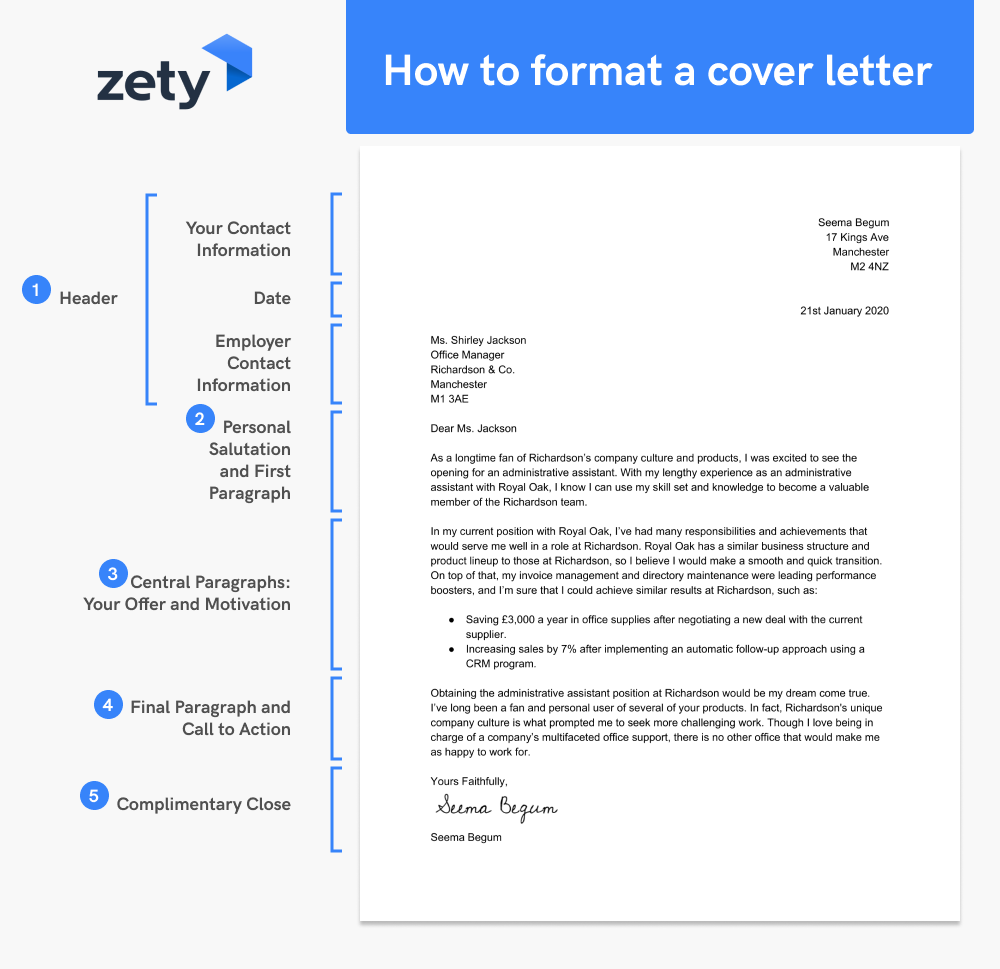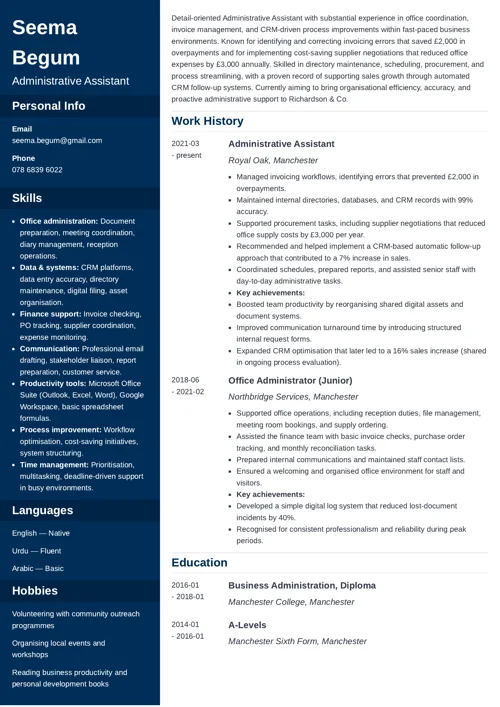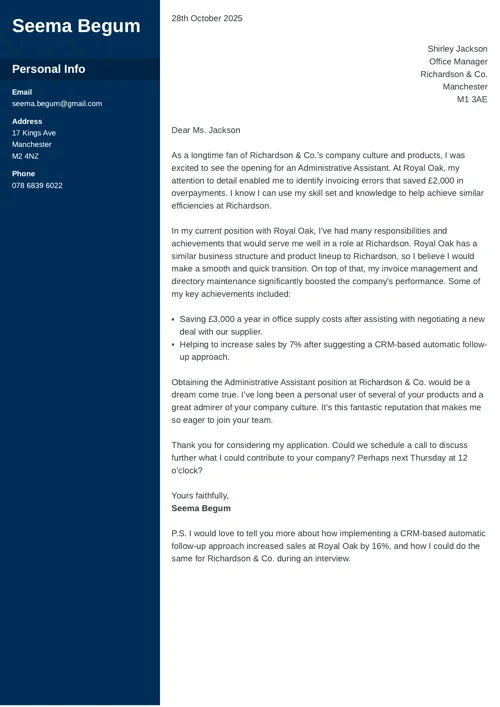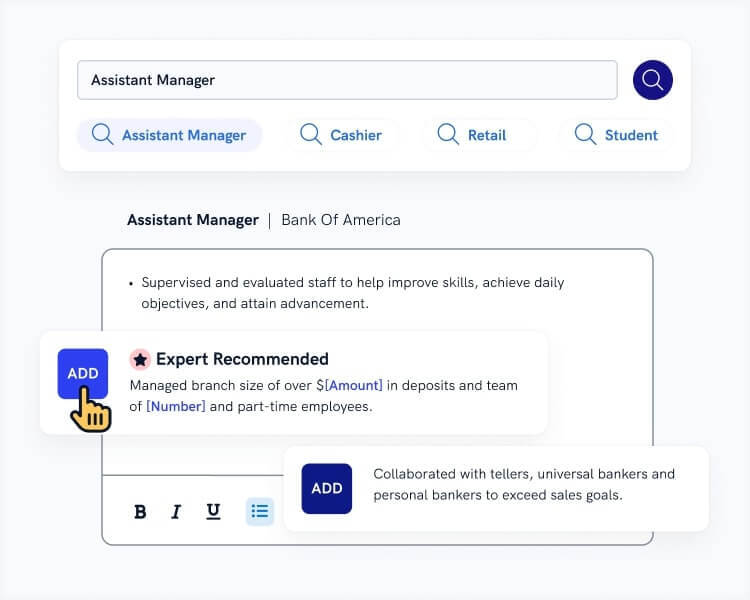Cover Letter Format UK: Examples, Tips, and Guide
Create your cover letter nowGetting the cover letter format right requires guidance. Good formatting acts as the instruction manual that turns your cover letter from a disorganised mess into a well-crafted, job-winning masterpiece. In a competitive job market, that little detail could be the difference between standing out and being overlooked.
This guide will show you:
- Why having a great cover letter layout is so important.
- How to structure a cover letter to win the hearts of your recruiters.
- Examples of UK cover letter formats for job applications.
- Tips for students and graduates, and how to handle cover letters if you have gaps in your CV.
Want to write your cover letter fast? Use our cover letter builder. Choose from 20+ professional cover letter templates that match your resume. See actionable examples and get expert tips along the way.
Sample Cover Letter for a CV—See more cover letter templates and create your cover letter here.
One of our users, Nikos, had this to say:
[I used] a nice template I found on Zety. My CV is now one page long, not three. With the same stuff.
UK cover letter format example
Seema Begum
17 Kings Ave
Manchester
M2 4NZ
seema.begum@gmail.com
078 6839 6022
28th October 2025
Shirley Jackson
Office Manager
Richardson & Co.
Manchester
M1 3AE
Dear Ms. Jackson
As a longtime fan of Richardson & Co.’s company culture and products, I was excited to see the opening for an Administrative Assistant. At Royal Oak, my attention to detail enabled me to identify invoicing errors that saved £2,000 in overpayments. I know I can use my skill set and knowledge to help achieve similar efficiencies at Richardson.
In my current position with Royal Oak, I’ve had many responsibilities and achievements that would serve me well in a role at Richardson. Royal Oak has a similar business structure and product lineup to Richardson, so I believe I would make a smooth and quick transition. On top of that, my invoice management and directory maintenance significantly boosted the company's performance. Some of my key achievements included:
- Saving £3,000 a year in office supply costs after assisting with negotiating a new deal with our supplier.
- Helping to increase sales by 7% after suggesting a CRM-based automatic follow-up approach.
Obtaining the Administrative Assistant position at Richardson & Co. would be a dream come true. I’ve long been a personal user of several of your products and a great admirer of your company culture. It’s this fantastic reputation that makes me so eager to join your team.
Thank you for considering my application. Could we schedule a call to discuss further what I could contribute to your company? Perhaps next Thursday at 12 o’clock?
Yours faithfully,
Seema Begum
P.S. I would love to tell you more about how implementing a CRM-based automatic follow-up approach increased sales at Royal Oak by 16%, and how I could do the same for Richardson & Co. during an interview.
Now, let’s see how to format a cover letter to make it work just as well as the one above.
How to structure a cover letter
The correct cover letter format resembles a one-page formal letter. Each section serves its own purpose and should be formatted correctly. Otherwise, it gives the recruiter an impression of carelessness.
📝 Here are all the important cover letter sections:
- Header with the contact information and date
- Formal salutation
- Opening paragraph
- One or two body paragraphs
- Closing paragraph
- Sign-off
- Postscript (optional)

Let’s move on to a section-by-section walk-through of a formal cover letter format in the UK, in which I will explain in detail the structure of a cover letter.
💡 Pro tip: Treat the formatting of your cover letter as a reflection of your personal brand. Ensure it appears professional and demonstrates your commitment to the role.
How to format a cover letter: UK section-by-section guide
You know the section names. But how to create them properly? Without further ado, let’s explore how to structure a cover letter and how each section should be formatted.
1. Header
You might be wondering how to start your cover letter. The answer is: with a header. It should be similar to your CV header when it comes to your information. However, that’s not the only information you’ll include there.
✅ The cover letter header consists of:
- Your contact information: aligned to the right, unless the template you’ve chosen places it elsewhere.
- The date: on the right, Day–Month–Year for UK cover letter format.
- The recipient’s contact information: on the left, unless the template specifies otherwise.
Seema Begum
17 Kings Ave
Manchester
M2 4NZ
seema.begum@gmail.com
078 6839 6022
28th October 2025
Shirley Jackson
Office Manager
Richardson & Co.
Manchester
M1 3AE
Perfect execution like this ensures that your cover letter makes a strong first impression. Do it this way, and you’ll immediately come across as polished and professional.
2. Cover letter salutation
Always start your cover letter with the recipient’s name to grab their attention and make a strong first impression quickly. Research indicates that hearing or seeing one's own name has a significant impact on the brain. Use it to your advantage.
What if you don’t know who to address your cover letter to?
- Look for the addressee’s name in the job ad.
- Search for the name on the company website or social media..
- Visit LinkedIn, where job postings often include the name of the person who posted the advert.
- Call the company and ask directly who to address your cover letter to, if all else fails.
If you can’t find the hiring manager’s name, don’t worry. Use “Dear Hiring Manager,” or, even better, “Dear [Team Name] Manager.” And if you’re unsure of the recipient’s gender or preferred title, spell out their full name instead (for example, “Dear Alex Jones”).
- Dear Ms. Jackson
- Dear Morgan Roberts
- Dear Hiring Manager
- Dear Accounts Payable Team Manager
Whatever you do, avoid using “To Whom It May Concern” or “Dear Sir/Madam.” These greetings are not only outdated (think Victorian-era formalities) but also impersonal and generic.
When making a CV in our builder, drag & drop bullet points, skills, and auto-fill the boring stuff. Spell check? Check. Start building a professional CV template here for free.
When you’re done, Zety’s CV builder will score your CV and tell you exactly how to make it better.
3. Opening paragraph
This part needs to capture the reader's interest from the start, because that’s the best way to keep them reading.
✅ Here’s how to write an opening paragraph for a cover letter:
- Mention the company and the position you’re applying for.
- Demonstrate your passion for the company and the role, drawing on your professional or personal experience.
- Mention a standout, quantifiable achievement that instantly positions you as the best candidate for the job.
- Never be generic. Hiring managers can tell in a flash if it’s a copy-paste job, so always tailor your cover letter to the job you’re applying for.
- Avoid any cliché statements. Make it personal, and tailor it to the specific company and role. That’s the way to grab the reader’s attention.
As a longtime fan of Richardson & Co.’s company culture and products, I was excited to see the opening for an Administrative Assistant. At Royal Oak, my attention to detail enabled me to identify invoicing errors that saved £2,000 in overpayments. I know I can use my skill set and knowledge to help achieve similar efficiencies at Richardson.
Beginning with the company name, highlighting some measurable achievements, and concluding with a promise to assist the employer: this is how you effectively craft your cover letter's opening paragraph.
Tailor your cover letter to each application by mirroring the job description's language and emphasising your relevant skills. A concise, well-structured format ensures clarity and professionalism.
4. Middle paragraph(s)
It’s time to move on to the real meat in the sandwich. And in the cover letter sandwich, that meat is its middle, just like in a real sandwich.
This section of the cover letter can consist of one or two paragraphs. Here’s where you show the employer what you have to offer and how they’d benefit from having you on their team. Consider it a sales pitch for why you’re the perfect candidate for this job.
📝 Here’s how to write the middle paragraphs of a cover letter:
- Use quantifiable achievements and specific examples to prove you’re the best candidate.
- Back up your claims with evidence. Hiring managers want to see what you can do for them.
- Use both your hard and soft skills to impress your future employer.
- Structure your statements using the PAR formula (Problem-Action-Result). These are also known as accomplishment statements.
- List your achievements with bullet points to improve the readability of your cover letter.
- Make it personal by dropping relevant names, mentioning the company, and referencing their website or social media to show research.
To sum up: ask not what the employer can do for you—show what you can do for the employer, to paraphrase John F. Kennedy. After all, that’s what the recruiter is interested in. Let’s see a good example of that:
In my current position with Royal Oak, I’ve had many responsibilities and achievements that would serve me well in a role at Richardson. Royal Oak has a similar business structure and product lineup to Richardson, so I believe I would make a smooth and quick transition. On top of that, my invoice management and directory maintenance significantly boosted the company's performance. Some of my key achievements included:
- Saving £3,000 a year in office supply costs after assisting with negotiating a new deal with our supplier.
- Helping to increase sales by 7% after suggesting a CRM-based automatic follow-up approach.
Looks impressive, doesn't it? Notice how these bullet points stand out from the content. It’s a simple way to catch your reader's eye with what’s most remarkable about your candidacy.
5. Closing paragraph
Your opening line was a banger that made the readers go that far. Now, as they’ve reached a cover letter ending, you must make them crave more. And more means: inviting you for an interview. Let’s see how it’s done.
📝 Here’s how to write a closing paragraph for a cover letter:
- Thank the hiring manager for their time and consideration, and reiterate your interest in the role.
- Express your enthusiasm about the prospect of working at the company you admire.
- Add a polite compliment to the company so you’re remembered as an appreciative and enthusiastic candidate.
- Repeat how your skills, experience, and achievements can be transferred to benefit the company. After all, that’s what interests your recruiter most.
- Finish with a call to action: suggest an interview or say you’re looking forward to discussing your application further.
Obtaining the Administrative Assistant position at Richardson & Co. would be a dream come true. I’ve long been a personal user of several of your products and a great admirer of your company culture. It’s this fantastic reputation that makes me so eager to join your team. Thank you for considering my application. Could we schedule a call to discuss further what I could contribute to your company? Perhaps next Thursday at 12 o’clock?
Ending on a positive note with a courteous compliment and a meeting offer: the entire conclusion appears thoroughly professional.
6. Complimentary close
No formal document is complete without a sign-off, and the same goes for your cover letter. And just like any other formal document, there are specific rules on how to do it correctly.
✅ How to make a cover letter sign-off?
- Use “Yours sincerely” if you know the addressee’s name.
- Use “Yours faithfully” if you don’t know the addressee’s name.
- Avoid informal sign-offs, even if the company you’re applying to seems casual.
- Sign your letter by hand if you’re printing a hard copy to post.
Yours faithfully,
Seema Begum
Now that your cover letter’s structure is ready, let’s see if there’s anything more you can highlight.
7. Postscript
If there’s one place to highlight your most interesting achievement, it’s in the cover letter postscript. And yes, it should be an accomplishment that’s truly intriguing, not necessarily your most significant one.
The purpose of including a P.S. in your cover letter is not only to impress, but it’s also to keep the reader even more interested in what you have to say. In fact, for highly competitive positions, a cleverly crafted P.S. can be your ultimate interview hook: a final, irresistible detail that makes the hiring manager remember you.
📝 How to write a cover letter postscript?
- Select one of your accomplishments to mention. Choose a remarkable one that you can talk about in more detail, even if it’s not directly related to the job opening.
- Write a single line that hints you’d love to elaborate on that achievement and how it impacted your previous company. Hint that this success can be replicated for the company you’re applying to.
- Express excitement about discussing it further during an interview. That’s an offer that’s hard to resist!
P.S. I would love to tell you more about how implementing a CRM-based automatic follow-up approach increased sales at Royal Oak by 16%, and how I could do the same for Richardson & Co. during an interview.
💡 Sometimes you might want to write something snappier. Learn how to do it right: How to Write a Short Cover Letter
Cover letter format template
Now that you know how to structure your cover letter properly, let me show you something useful. Here’s a ready-to-copy cover letter format template. Simply swap out the brackets with details specific to your job application, add a few tips from this article, and your cover letter will be ready to send.
Cover letter format: UK template
[Your name]
[Your job title]
[Your address]
[Post code]
[Your phone number]
[Your email address]
[Date]
[Hiring manager’s name]
[Company name]
[Company address]
[Post code]
Dear [Ms./Mr.] [Hiring Manager’s Last Name],
I am thrilled to apply for the [position title] role at [company name]. With [number of years] of experience in [relevant industry or skills], I can make a significant contribution to the success of your team.
Currently, as a [job title] at [current company], I am responsible for [key responsibilities and their impact]. I proved to be a skilled specialist by:
- [#1 quantifiable accomplishment]
- [#2 quantifiable accomplishment]
- [#3 quantifiable accomplishment]
My expertise in [relevant skill] and [another relevant skill] makes me an ideal candidate for the [job title] position at [company name]. It will be my pleasure to contribute my skills to [company goal or project].
I would welcome the opportunity to discuss how my experience aligns with [company name] needs. Perhaps during a face-to-face meeting in your office on [date] at [hour of the interview]?
Kind regards,
[Your Name]
[Your email address]
[Your phone number]
P.S. I would love to tell you more about how [achievement + impact], and how I could do the same for [company name] during an interview.
💡 Learn more: How to Write a Cover Letter
Cover letter email format
Most cover letters are now sent electronically. If you’re sending it as an email attachment or uploading it to a company website, then follow the cover letter formatting rules above. However, if you’re sending your letter in the body of an email, you should make a few changes to the format.
How to format an email cover letter
- Write a clear and professional subject line: They need to see who you are and what you’re applying for at a glance. So state your name and the job you’re applying for, e.g. “Application for Staff Accountant Position—Richard Simms.”
- Move your contact info: Starting an email with contact details looks odd. So move your contact details to be in your signature below your complimentary close.
- Remove the recipient’s contact info and the date: This information isn’t necessary for an email. But do still greet the hiring manager by name in your salutation.
- Avoid typos and don’t rely on auto-complete: Take care to proofread your email cover letter before you click send.
- Choose an easy-to-read font: Email cover letters still need clarity and readability.
And that’s it. Now you know how to create a flawlessly formatted cover letter in both a template that matches a CV you’ve written and the body of an email.
💡 Learn more: Email Cover Letter Template for 2026
10 Tips for formatting your cover letter layout
Did you know that an average corporate job opening attracts 250 applications? That’s why your cover letter needs to be as neat as possible. Otherwise, how are you going to make that great first impression?
Follow these 10 expert tips to make your cover letter layout sleek and professional, capturing the attention of potential employers:
- Match your resume’s design. They should look like a cohesive set. Use the same font, colour scheme, and header style.
- Keep it to one page (about 300–400 words). Make every sentence meaningful.
- Choose a simple, easy-to-read font, such as Calibri, Helvetica, Arial, or Times New Roman. Stick to 11–12 pt font size.
- Use 0.5" to 1" margins around to avoid a cramped or sparse cover letter.
- Make spacing consistent: paragraphs should be single-spaced, but add a blank line between each section.
- Add bullet points when discussing your achievements or skills. It makes your cover letter more skimmable.
- Highlight key details with subtle formatting. Use bold text for company names or job titles and italics for minor details. Avoid underlining and excessive styling.
- Export your letter as a PDF (unless the employer asks otherwise). This preserves formatting across devices.
- Write in a professional tone. Your letter should sound approachable but still professional.
- Send it from a professional email address. Avoid outdated or silly email handles. Your name (or a variation) works best.
💡Craving more tips on writing a cover letter? See our guide: Best Cover Letter Tips for 2026
Plus, a great cover letter that matches your CV will give you an advantage over other candidates. You can write it in our cover letter builder here. Here's what it may look like:
See more cover letter templates and start writing.
Key Takeaway
Getting your cover letter format right is perfect for showing off your professionalism and written communication skills.
Here’s how to format your cover letter the right way:
- Use the correct margins, alignment, and spacing.
- Choose a clear, readable font and a maximum length of one page.
- Address your cover letter correctly and use a personalised salutation.
- Use the right structure for the body of your cover letter.
- Finish off strongly with a call to action.
- If you’re sending your cover letter as an email, alter your format accordingly.
And that’s it. Good luck with your cover letter!
About Zety’s Editorial Process
This article has been reviewed by our editorial team to make sure it follows Zety's editorial guidelines. We’re committed to sharing our expertise and giving you trustworthy career advice tailored to your needs. High-quality content is what brings over 40 million readers to our site every year. But we don't stop there. Our team conducts original research to understand the job market better, and we pride ourselves on being quoted by top universities and prime media outlets from around the world.






![CV Layout: How to Lay Out a Professional CV [5+ Examples]](https://cdn-images.zety.com/pages/cv_layout_uk_9.jpg?fit=crop&h=250&dpr=2)
![Graduate CV: Examples, Template + Writing Guide [2026]](https://cdn-images.zety.com/pages/graduate_cv_example_uk_10.jpg?fit=crop&h=250&dpr=2)